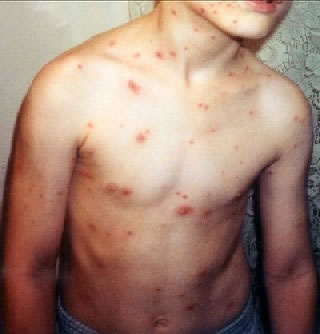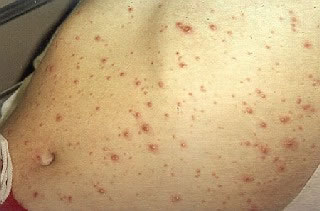What’s Going Around
Chickenpox
Is this your child's symptom?
- A rash all over the body caused by the chickenpox virus.
- The chickenpox rash starts as small red bumps. The bumps change to blisters or pimples. The bumps change to open sores, and finally they scab over.
- A doctor has told you that your child has chickenpox.
- Or your child had close contact with another person who has it (or shingles). The contact should be 10-21 days earlier.
Symptoms of Chickenpox
- Chickenpox starts with some small water blisters or pimples on the head and trunk.
- Chickenpox progress within 24 hours through the next 5 stages:
- Small red bumps
- Thin-walled water blisters
- Cloudy blisters
- Open sores, and finally
- Dry brown crusts.
- Rash is all over the body. Most often, starts on the head and back.
- Repeated crops of new chickenpox keep appearing for 4 to 5 days. Therefore, all 5 stages are present at same time.
- Sores (ulcers) can also occur in the mouth, on eyelids, and on genitals.
- Fever is most often present. The more the rash, the higher the fever.
- Known contact to a child with chickenpox or shingles 10 - 21 days earlier
- Main related problems: skin infections from scratching.
Cause of Chickenpox
- Chickenpox is caused by a virus. It is called Varicella.
- Chickenpox can be prevented by getting this vaccine against this virus.
When to Call Us for Chickenpox
Call 911 Now
Call Doctor or Seek Care Now
| Contact Doctor Within 24 Hours
Contact Doctor During Office Hours
| Self Care at Home
|
Care Advice for Chickenpox
- What You Should Know About Chickenpox:
- Chickenpox is caused by the varicella virus.
- It's now uncommon because of the chickenpox vaccine.
- Your job is to keep your child comfortable and to limit the itching.
- Here is some care advice that should help.
- Cool Baths for Itching:
- For itching, give cool or lukewarm baths for 10 minutes as often as needed.
- Caution: avoid any chill.
- Can add baking soda 2 ounces (60 mL) per tub.
- Baths don't spread the chickenpox.
- Do not use soaps. Reason: soaps cause dry skin and make the itch worse.
- Calamine Lotion for Itching:
- Put calamine lotion on the chickenpox that itch the most.
- You can also use an ice cube on the itchy spots for 10 minutes.
- Don't use any lotion containing Benadryl in it. Reason: it can be absorbed across the skin. This can cause side effects in kids.
- Allergy Medicine for Itching:
- If itching becomes severe, give a dose of Benadryl.
- No prescription is needed. Age limit: 1 and older.
- Try Not to Scratch:
- Try not to let your child pick and scratch at the sores. This can lead to infected sores.
- Trim fingernails.
- Wash hands often with soap.
- Fever Medicine:
- Give acetaminophen (such as Tylenol) for fever above 102° F (39° C).
- Never use aspirin. Reason: risk of Reye syndrome.
- Also, don't use ibuprofen products (such as Advil). Reason: may increase risk of bad strep skin infections.
- Fluids and Soft Diet:
- The mouth and throat ulcers are painful. Try to get your child to drink adequate fluids.
- Goal: keep your child well hydrated.
- Cold drinks, milk shakes, popsicles, slushes, and sherbet are good choices.
- Solids. Offer a soft diet. Also, avoid foods that need much chewing. Avoid citrus, salty, or spicy foods. Note: fluid intake is more important than eating any solids.
- For babies, you may need to stop the bottle. Give fluids by cup, spoon or syringe instead. Reason: the nipple can increase the pain.
- Liquid Antacid for Mouth Pain (Age 1 Year and Older):
- For mouth pain, use a liquid antacid (such as Mylanta or the store brand). Give 4 times per day as needed. After meals often is a good time.
- Age 1 to 6 years. Put a few drops in the mouth. Can also put it on with a cotton swab.
- Age over 6 years. Use 1 teaspoon (5 mL) as a mouth wash. Keep it on the ulcers as long as possible. Then can spit it out or swallow it.
- Caution: do not use regular mouth washes, because they sting.
- Ointment For Pain With Passing Urine:
- For girls with painful genital ulcers, use petroleum jelly (such as Vaseline).
- Put on the sores as needed.
- For males with painful pox on the tip of the penis, this also works.
- Return to School:
- Your child can go back to school after all the sores have crusted over.
- Most often, this is day 6 or 7 of the rash.
- What to Expect:
- Expect new chickenpox every day for 4 or 5 days.
- Most children get 400 to 500 chickenpox.
- They get less pox if they've had the vaccine.
- Prevent the Spread of Chickenpox in the Office:
- If your child needs to be seen, call first to the office.
- Try to bring another adult. Have one adult enter the office first for instructions.
- For nonurgent problems, the doctor may do an exam in the car.
- Call Your Doctor If:
- Chickenpox look infected (draining pus, scabs become larger)
- Gets any new chickenpox after day 6
- You think your child needs to be seen
- Your child becomes worse
And remember, contact your doctor if your child develops any of the 'Call Your Doctor' symptoms.
Disclaimer: this health information is for educational purposes only. You, the reader, assume full responsibility for how you choose to use it.

Chickenpox is an infectious disease caused by the varicella-zoster virus. It results in an itchy blister-like rash, tiredness and fever.
It appears first on the trunk and face, but can spread over the entire body. It may cause between 250 and 500 itchy blisters. The rash is no longer contagious when all of the spots are crusted over and no new spots are appearing. This usually takes 7 days from the start of the rash.

The Chickenpox rash can occur on all body surfaces. The rash is raised, red and itchy.
The rash is no longer contagious when all of the spots are crusted over and no new spots are appearing. This usually takes 7 days after the rash first appears.
Copyright 2000-2023. Schmitt Pediatric Guidelines LLC.
